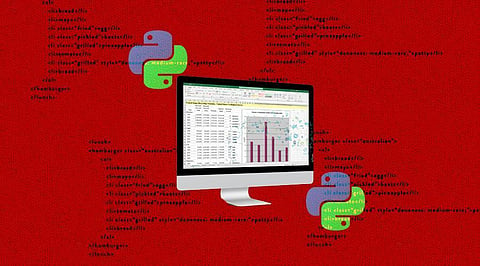

If you ever need to use a spreadsheet and Python programming simultaneously, Grist will be your best option. Apparently, it looks like a spreadsheet, but underneath it has SQLite tables, and its formula language is Python. Even though the code is open source, free and paid plans are available if you require a host.
For first-time users, there are also choices to use without logging in. The user can either work on a blank spreadsheet or uses a template. However, if you are only used to working with spreadsheets, it will take you some time to get used to Grist. It has a spreadsheet-like interface on a database. So, if you have a row with a quantity and a price, you might add a column that computes the total cost. That's fine, but you've now done that for every row in the table. Depending on your point of view, that might be a feature. What if you want a grand total at the bottom? Then you add a widget which is actually a separate table.
You can fork spreadsheets and reconcile copies sort of like merging source-controlled programs. You can easily make dashboards and different views on data. For example, if you want to see which goat begat which goat, there's an example to use for that. Since this is Hackaday, you might prefer a Morse code quiz. This seems like a good balance between coding everything and the much-vaunted "no code" tools floating around. Honestly, we might be as comfortable with Jupyter. But this spreadsheet-like structure will make it more palatable in certain situations.
In terms of computer technology, Excel and Python have both been around for a very long time: Excel was first launched in 1985 by Microsoft—and this may come as a surprise to many—it was only available for Apple Macintosh. It wasn't until 1987 that Microsoft Windows got its first version in the form of Excel 2.0. Microsoft wasn't the first player in the spreadsheet market, though: VisiCorp came out with VisiCalc in 1979, followed by Lotus Software in 1983 with Lotus 1-2-3. And Microsoft didn't lead with Excel: three years earlier, they released Multiplan, a spreadsheet program that could be used on MS-DOS and a few other operating systems, but not on Windows.
Python was born in 1991, only six years after Excel. While Excel became popular early on, it took Python a bit longer until it got adopted in certain areas like web development or system administration. In 2005, Python started to become a serious alternative for scientific computing when NumPy, a package for array-based computing and linear algebra, was first released. NumPy combined two predecessor packages and therefore streamlined all development efforts around scientific computing into a single project. Today, it forms the basis of countless scientific packages, including pandas, which came out in 2008 and which is largely responsible for the widespread adoption of Python in the world of data science and finance that started to happen after 2010. Thanks to pandas, Python, alongside R, has become one of the most commonly used languages for data science tasks like data analysis, statistics, and machine learning.
The fact that Python and Excel were both invented a long time ago isn't the only thing they have in common: Excel and Python are also both programming languages. While you are probably not surprised to hear that about Python, it may require an explanation for Excel, which I'll give you next.
Join our WhatsApp Channel to get the latest news, exclusives and videos on WhatsApp
_____________
Disclaimer: Analytics Insight does not provide financial advice or guidance. Also note that the cryptocurrencies mentioned/listed on the website could potentially be scams, i.e. designed to induce you to invest financial resources that may be lost forever and not be recoverable once investments are made. You are responsible for conducting your own research (DYOR) before making any investments. Read more here.
